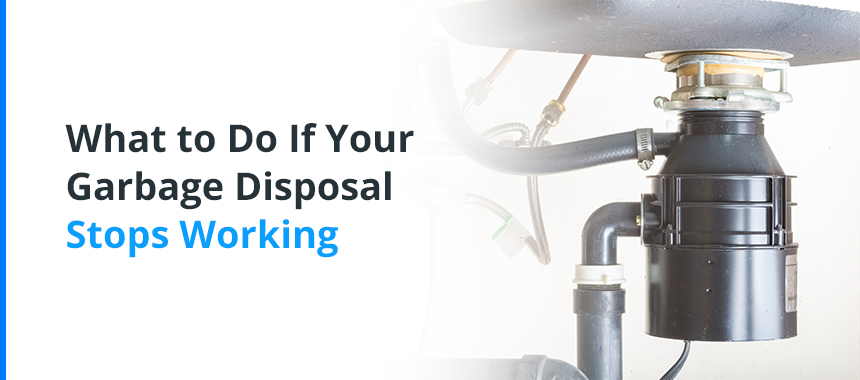
Garbage disposals are a wonderful invention. They allow you to wash and rinse dishes without worrying about every particle of food stuck to the plates. While food waste and plumbing are typically two things best kept apart, a garbage disposal can send ground-up food down the drain without a care in the world.
That’s until you realize you have a clogged drain. When the water in one basin flows down the drain as normal, the other starts to fill up. You stop the water, step back and wonder what in the world is going on. Aren’t garbage disposals supposed to be clog-free? Unfortunately, that’s not always the case. Take a look at the proper way to use your garbage disposal so you can save yourself from this unfortunate scenario.
How to Turn Your Garbage Disposal on and Off
The first step in using your garbage disposal is knowing how to turn it on and off. You’ll control both parts of the process since most garbage disposals do not have an automatic shutoff feature. Prepare yourself for the noise, since garbage disposals can be loud when they’re on — especially when they’re grinding food items.
Most garbage disposals have a switch on a nearby wall to turn them on and off. Stand in front of your garbage disposal and look for this switch. It could be hiding out of eyesight under a cabinet or behind another kitchen appliance. When you flip the switch to turn on the garbage disposal, it will start spinning its blades. Flip the switch in the opposite direction to turn it off again, bringing the blades back to a stationary position.
If turning on the switch doesn’t work, check if you need to plug the garbage disposal into a wall outlet. You may need to reset the breaker to reestablish an electrical connection with the motor.
Should You Run Water With Your Garbage Disposal On?
Before you start using your garbage disposal, you should first understand its relationship with water. Water is essential to your disposal’s functionality. Never dry-grind pieces of food in your garbage disposal, as this is a clogged sink waiting to happen.

Consider the steps you take when you swallow a pill. Swallowing the pill dry is difficult and can even result in choking. Instead, taking it with a mouthful of water helps it go down more smoothly. The same principle applies to your garbage disposal. Without the proper flow of water, food can get stuck, clogging the drain and even leading to damaged blades.
While your garbage disposal may seem invincible, it needs special care and treatment like any other mechanical device. Just as failing to put oil in your car can result in engine malfunctions, water acts as a lubricant for your garbage disposal, keeping the blades spinning and the food particles flowing. Water reduces stress on your disposal, allowing it to work properly for years to come.
Should You Run Hot or Cold Water Down Your Garbage Disposal?
While you know you need to use water when operating this appliance, the question of hot versus cold water remains. With this device, cold water is best.
That answer may come as a surprise since everyone associates warm and hot water with cleaning. Adults tell children to wash their hands with warm water. Anyone who’s cleaned dishes understands that hot water does a better job than cold water. Why, then, is cold water better than hot water for your garbage disposal?
Using cold water is crucial because of oil, grease and other fats present when rinsing off dishes. Common fatty foods include various types of meat as well as cheese products, salad dressings and other items. Warm water loosens these substances and can turn them from chunky solids into runny liquids. These oils can settle in your pipes and harden once they cool off, creating clogs.

Cold water has a different effect on these oily substances. When you rinse oils with cold water, the lower temperatures solidify the oils. Your garbage disposal’s blades can separate the solid fats into individual particles. The cold water will keep the oil particles flowing down your pipes instead of letting them settle and harden in one large chunk. It may seem like the opposite of what your parents taught you, but when it comes to garbage disposals, you need to use cold water.
Tips on How to Use a Garbage Disposal Properly
Now that you know the basics of using your garbage disposal, take your knowledge a step further. Use the following tips and tricks to keep your garbage disposal functioning at peak performance:
1. Run Plenty of Water
Start running cold water before putting any food in your disposal, and keep it running as you insert food waste. Leave the water on for a few seconds after you’ve turned off the disposal to rinse the remaining particles down the drain. This method for flushing food helps keep the blades from becoming overwhelmed.
2. Scrape Food Waste From Plates Into the Trash
Avoid overusing your garbage disposal by scraping off plates before starting the dishes. Pouring too much food down the drain can quickly result in issues, and some food waste should ideally stay out of the garbage disposal anyway. The blades will stay sharp when they have less grinding to do.
3. Use Your Garbage Disposal Regularly
Your appliance’s blades can rust or get stuck in place if you neglect to run it every so often. Use your garbage disposal every day to keep it in better shape. If you rarely use your garbage disposal because you eat out frequently or prefer to use disposable plates, it’s a good idea to occasionally grind up some ice or citrus peels on days when your sink was unused.
4. Take It Slow
Insert food waste slowly. Adding too much food too rapidly can jam the blades. Instead, cut up your food waste into smaller pieces. Then add these smaller pieces to the garbage disposal a little at a time.
5. Avoid Certain Food Items
Your garbage disposal can only grind up certain foods. Throw pits, bones, corn husks pasta noodles and other hard or fibrous food items into your regular kitchen trash can. Both frying grease and cooking oil can harden in the pipes and cause sticky clogs as other food wastes become trapped.
Do not grind up non-food items, which can result in a clogged garbage disposal or serious damage that requires a plumber’s assistance. The garbage disposal is designed to expel food only.
6. Toss in Some Ice Cubes
You’ll need to clean the inner workings of your garbage disposal from time to time. Add a few ice cubes to your appliance and turn it on for a simple way to clean the system. The ice shards will dislodge food particles stuck to the inside. For some extra cleaning power, add some rock salt to your garbage disposal before turning it on.
7. Enjoy a Fresh Smell Using Citrus Fruits
Add an occasional lemon, lime or clementine to your garbage disposal and turn it on. The acidic juices and rinds from these fruits can clean away food particles and add a pleasant scent to your sink. Citrus is a natural antimicrobial and deodorizing agent.
8. Only Use Cleaning Agents Safe for Garbage Disposals and Pipes
Avoid using bleach or drain cleaner to dislodge a clog. This could damage your plumbing and the disposal blades. Look for cleaners designed for sinks with garbage disposals, or use a natural cleaning agent like vinegar, which is effective and safe.
How to Clean a Garbage Disposal
Follow these steps for a routine cleaning or resolving a clogged garbage disposal:
- Flip the power breaker off: Disconnect the power to stay safe while you work. This will prevent the garbage disposal from accidentally being flipped on.
- Remove the splash guard: If you use a splash guard or equivalent device, take it out so you can work inside the drain.
- Shine a flashlight into the drain: Check for visible blockages, food scraps, fluid retention or other problems.
- Use pliers or tongs to pull out any trapped objects: Avoid using your fingers to reach into the drain. With the power disabled, the blades will remain stationary, but they are still sharp.
- Restore the power for cleaning: Now, it’s time to try a few methods for cleaning the blades, so you will want them to be able to activate.
- Soak with baking soda and vinegar: Pour baking soda into the drain, and after it sits for about half an hour, flush it out with vinegar. Follow by rinsing with cold water to neutralize the mixture. These household kitchen items function as a natural cleaner that is gentler and safer to use than harsh chemicals.
Choose Leggett Inc. for High-Quality Garbage Disposal Repair and Maintenance
If your new home’s garbage disposal is having problems, trust the skillful, certified technicians at Leggett for repair and maintenance. Garbage disposals can be tricky and dangerous to repair on your own. Save yourself the trouble and let Leggett handle the job — we handle everything from maintenance to garbage disposal replacement installations.
We’ve provided central Pennsylvania and surrounding areas with quality services since our founding in 1966. Our experts have certifications in various industries, so you can turn to us when the items you rely on break down. Or, count on our technicians for maintenance to keep your items functioning like new year-round.
Contact us today to learn more about what makes us the area’s best service technicians and request an estimate. We look forward to serving you!



